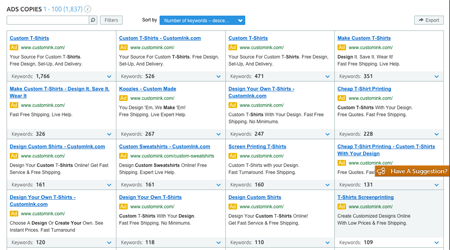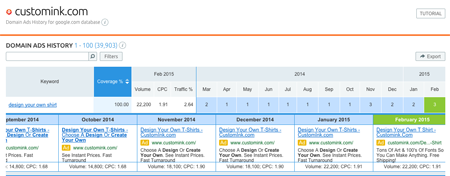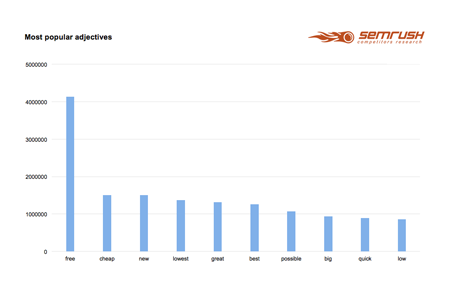4 Tips for Increasing Ecommerce Ad Effectiveness

If it feels like your ecommerce advertising is like trying to win a Formula 1 race on a bike you're not alone.
It's possible to come in first but not likely...
The competition is stronger, fiercer and enjoys way more horsepower.
Not to mention they're everywhere too.
It doesn't matter what channels you try and how well you optimize campaigns there's always someone up ahead.
If you struggle with promoting your store with AdWords PPC, Facebook ads or PLAs, read on. I'm going to show you a few tricks to turn your advertising efforts around.
Tip 1. Start Bidding on Brand Keywords
Brand is everything in today's marketing.
It establishes trust, communicates a story and helps customers identify with your store.
And yet I bet you still prefer to bid on non-branded keywords first.
After all, they offer a far greater traffic opportunity, true. But it's the brand keywords that offer the greatest benefits for your store:
Brand keywords help secure a search results real estate. Bidding on your brand terms prevents competition from showing up for them instead.
They bring traffic that converts. Customers are likely to search by product category or name while researching available alternatives. But once their mind is made up, they often use brand keywords to access a store they want to buy from.
They are way cheaper than generic ones. Since there's less competition bidding on those keywords, they are more affordable while offering a great scope for good ROI.
But don't stop at your brand-related keywords.
To increase your advertising ROI bid on your competitors' brand too.
People searching for a specific brand are likely to click on listings related to it. But some will also be prone to discovering new opportunities and solutions.
Bidding on your competitor's brand gives you a chance to present your business to highly targeted customers.
And it's not as unethical as you'd think.
As Ted Ives from Search Engine Land puts it,
"...it has been generally accepted in the online marketing industry for several years now that it's OK to *bid* on competitor brand terms as longs as the competitor's terms don't show up *in your creatives* (e.g.. the ad text itself)."
In other words, as long as you don't deceive searchers by pretending to be the competitor, bidding on their brand terms is fairly legal.
Finding Competitor's Brand Keywords
When bidding for a competitor's brand, it's common to just set ads for their company name, website or product.
There could be however many other variations of their brand keywords customers might use while searching.
You can quickly discover them in different software offerings. Just research keywords associated with a domain and then click on any of the brand keywords. Certain SEO solutions will output a report on any other variation of the keyword along with any additional data:
- Traffic volume;
- Average Cost Per Click;
- Competition;
- Organic results;
- Trends and more.


(SEMrush Brand Keyword report for customink.com)
Tip 2. Mimic Your Competition
We've spoken about the benefits of conducting a thorough competitive research before. So just to reiterate:
Competitive research helps make more informed business decisions. Knowing what strategies have worked for your competitors will help you make more focused decisions regarding your strategies.
It can help spot new marketing opportunities. Researching competitors' strategies can help identify gaps in their marketing plan.
With competitive intelligence you can anticipate what your competitors are planning next. A new trend in their marketing, keywords they try to optimize for or landing pages they've launched can reveal their next moves.
It can help identify your competitive advantage. Lastly, competitive intelligence will help you assess your strengths versus a competitor and use this knowledge to overtake them in marketing efforts.
But here's how you could use it to improve your ads' effectiveness:
Research their PPC strategies
A quick research on a competitor's PPC strategies can reveal which keywords work for them, how much they spend monthly, their estimated online advertising budget and how much traffic they get from their efforts.
Assess their Ad Copy
While keywords are the foundation of an online advertising strategy, ad copy is what convinces users to click on your ad. A strong copy can entice more users to click an ad even if it doesn't appear as a first result.
There are many tricks companies use to entice users to click their ads:
- Target their specific needs;
- Speak to their emotions;
- Use trigger words;
- Make irresistible offers;
- Include strong call to action and many more.
In some software solutions you to view your competitor's ad copy in two ways.
You can see all their current ads:

But you can also view ad copy history to see how they improved an ad for a particular keyword.

This report alone offers a wealth of information you can use to discover your competitors' best advertising practices from.
Research Their PLA Strategies
As I've said already, the battle for ecommerce clicks and conversions from search engines is on.
And the competition is brutal.
What's more, the merge of Product Listing Ads to Shopping Campaigns has given your competitors one more channel to steal your customers.
To beat them, first you need to establish if they use PLAs at all. One way to do it is by Googling various keywords associated with your products. Another, use dedicated PLA software.
And if they do, you need to find out what strategies they employ to win your traffic.
The most common include:
- Displaying star ratings;
- Featuring high-quality images (ideally on white background);
- Competing on price.
There is no easy way to do this however. You can either use software or check their ads by hand to assess what you need to do to overtake them.
Tip 3. Make Your Ad Copy Irresistible
While we're on the subject of ad copy, there are few other things you could do to make it more relevant and enticing to your target audience.
Include Trigger Words
In our last year's research we discovered that there are certain words PPC advertisers tend to use more often than others. And to no surprise, users tend to respond to those words better.
Words like free, cheap or new top the list of the most popular adjectives while low, quick and big close the list.

State A Killer Offer
Nothing works better to entice someone to buy than a good deal. This study by the Global Journal of Management and Business Studies discovered that we are only loyal to a brand as long as we don't discover a better deal somewhere else.
The most popular buying incentives in ecommerce include:
- Free shipping. After product's quality, free shipping is the second-highest factor influencing a buying decision.
- Easy returns. Being able to easily return an item overcomes one of the biggest objections from buying online.
- Testimonials/Reviews. 90 percent of customers say their buying decision is based on online reviews. Of course you can't include any reviews in your ad copy. But you can mention the amount of good reviews you have or include star rating in your PLA ads.
Structure your copy on the AIDA model
The 25 characters limit in the headline and 35 in each line of your AdWords ad certainly reduces your opportunity to express everything you'd want to communicate to a potential customers.
At the same time, this limitation can work to your benefit if you structure your ad right.
One way to do so is by using the AIDA model.
AIDA stands for:
- Attention. That's the role of your headline. It should grab a customer's attention but also, communicate that an ad is relevant to them.
- Interest. Follow it with a description of the main benefit of a product or service.
- Desire. Next, provide a user with a reason to click. That's the time to mention your offer.
- Action. Lastly, close the ad with a strong call to action that compels them to act.
Tip 4. Reduce Bids on Poorly Performing Products
Lastly, this is one of the quickest fixes that will make a huge difference to your advertising.
I'm sure you know the Pareto principle - in the context of your advertising it would say that 80 percent of your revenue comes from 20 percent of your products.
The rest, if you advertise them as well will just eat up your daily budget.
A good practice therefore is to identify the worst performing products and reduce or even stop bidding on them entirely.
Want the Bad News First?
Ecommerce advertising is difficult.
In spite of a fierce competition and a rising cost, it's still possible to generate a strong ROI from online ads. For that to happen you need to focus not only on optimizing bids but also, making sure you use every trick possible to create ads irresistible to click.








